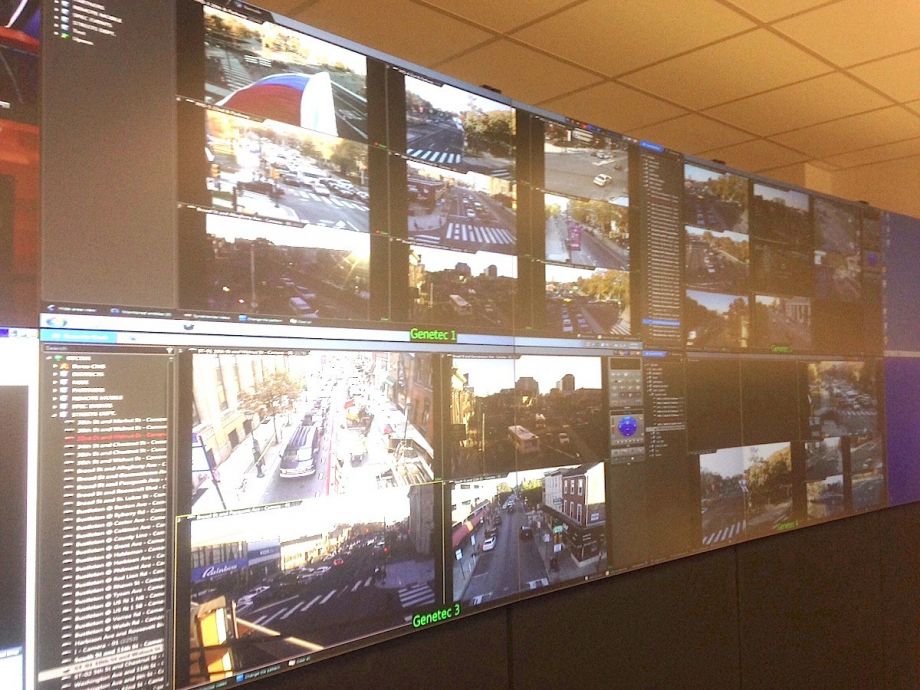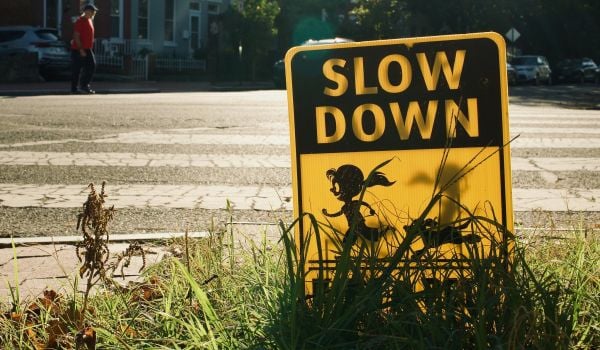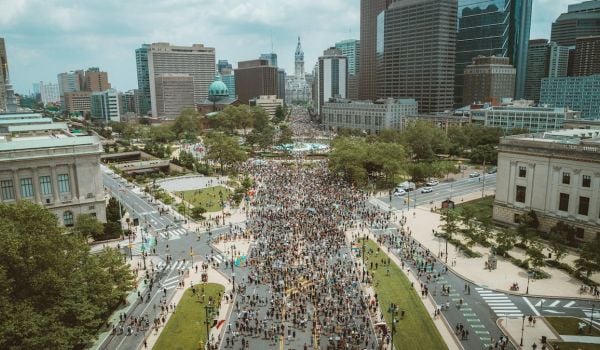As hundreds of thousands of people reveled in Philadelphia’s car-free city center during Pope Francis’ visit in September, the City of Philadelphia was rolling out a high-tech traffic control center 20 years in the making.
A new traffic control center, located in the Streets Department’s sign shop, is a command post where personnel can monitor traffic flow at intersections all over the city’s 135 square miles using 100 cameras at intersections maintained by the city and a slew of partner organizations. There are also feeds from 250 police cameras, as well as views plugged into eyes from SEPTA, the regional transportation authority, and the state department of transportation. The center can also receive feeds from cameras installed for special events like the papal visit and from cameras run by university police departments. Analysts view real-time information on a large bank of video displays.
“The goal has always been to better manage our streets and to try to make our streets safer for all users,” says Richard Montanez, chief of traffic and street lighting, mentioning motorists, bicyclists and transit riders.
The center allows the city to monitor the performance of “complete streets” such as Pine and Spruce streets in Center City, where signals are set to maintain a steady 20 mph speed for motor vehicles and bicycles have a buffered bike lane. If construction projects affect the flow of traffic, control center staff can adjust signal timing to smooth things out; if congestion causes traffic to back up, staff can alter signal cycles to reduce it.
Key to doing all this, however, is technology that has not yet been installed citywide: programmable, computer-controlled traffic signal boxes. About half the city’s signal control boxes are still the electromechanical variety whose timing cannot be adjusted on the fly. As those are replaced by the more modern control boxes, the city will better be able to manage the flow of traffic on its streets.
The signal control boxes, however, aren’t the only things the center can program. Staff can also adjust or modify the lighted pylons on the South Street bridge to display certain colors or patterns.
The center, which cost $600,000 to build, went live on September 15th, just in time for the Pope’s arrival.
The city has benefitted from being a later adopter of traffic control center technology. “Of the top 23 cities in the U.S., we were the only one without one,” Montanez says. This enabled him to visit other installations, watch them in operation and ask people what things they would do differently were they designing a facility now.
A consistent response: Install larger servers for the needed data communications. “You can never make them big enough,” he says, and the city center’s nearly full server rack demonstrates the truth of this observation.
The city expects to see benefits beyond improved traffic flow and complete streets. One area where the data and images the center provides can improve the city’s road transportation network is in designing streets and intersections.
“One of the things is it allows us to examine the human factor. We may engineer things one way, but people use them another way,” he says, pointing to an example on the control center’s screens where a bridge-replacement project (near Philadelphia’s Logan Circle) has altered traffic patterns — and crosswalks — at a big intersection. Despite bollards and “no pedestrian crossing” signs, people were continuing to walk along a small strip of asphalt inside the bollards. (Editor’s Note: The construction area has since been altered so it’s not so easy for pedestrians to walk where they shouldn’t.)
Montanez says the city also expects to use the center to improve the performance of local services from mass transit to snow removal. “We’re also going to be able to monitor snow operations, to see how well streets are being cleared all over the city,” Montanez says. The center also shares video feeds with control centers at SEPTA and the Pennsylvania Department of Transportation so those agencies can keep track of bus service and state highway conditions.
Currently, the center is staffed during the day, and at other hours, monitors at the PennDOT traffic control center watch over city intersections. Montanez plans to add staff over time to the point where the city can monitor its streets at least 18 hours each day.

Next City contributor Sandy Smith is the home and real estate editor at Philadelphia magazine. Over the years, his work has appeared in Hidden City Philadelphia, the Philadelphia Inquirer and other local and regional publications. His interest in cities stretches back to his youth in Kansas City, and his career in journalism and media relations extends back that far as well.
Follow Sandy .(JavaScript must be enabled to view this email address)
















